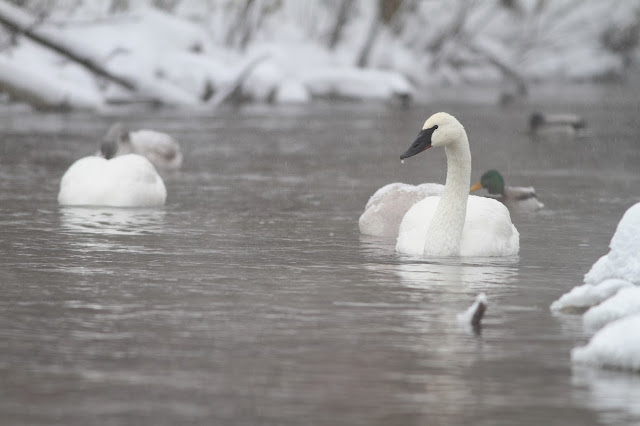Trumpeter Swans and Open Water 8 December 2013
A breath of fresh air, the snow this winter is light and airy, the temperatures are freezing cold, and Winter is back to visit Wisconsin and Minnesota in a most classic way! In an era of temperamental climate and uncertain futures, a winter like this is so welcome. As the temperatures dive to below zero Fahrenheit, the moving current of a wintery brook maintains enough water open to keep the swans close to their Springtime breeding haunts. While they haven't reached the frenzied exuberance of late February's breeding behavior, they are majestic and beautiful in the soft, clean snows nearer to the Winter Solstice.
The recovery of the Trumpeter Swan from the brink of extinction is a resonating reminder that we are to be optimistic, forward thinking, and joyous. The swans live each day in pursuit of another day, thriving in social activity and the beauty of the wild. They live well, and they live long. One of Wisconsin's banded Trumpeters is 25 years old this year.
Trumpeter Swans mate for life. Locally, one pair of banded birds (62K and 68K) have remained together for at least five years, raising cygnets every year. They are also very territorial and return to the same breeding locations many years running. Banded swan 89K has returned to the same bay of the same tiny lake to breed successfully three years in a row. Their family ties are strong in the winter, and family groups are often apparent.
This time of year, open water invites mixed groups of waterfowl. This particular stream always invites Canada Geese and Mallards. When there aren't any rare or unusual birds, there is equal entertainment in behavior. Mallards have begun securing and reinforcing pair bonds in the autumn, and they will continue the rituals into the breeding season. This elaborate behavior builds an investment in the bond and also serves to isolate the mallards as breeding partners. In evolutionary context, it is a pre-zygotic isolating mechanism, an elaborate dance that serves as a complex gateway. Without the agreement of the dance, there will not be fertilization. It is a ritual that makes a mallard a mallard.
The silent, peaceful snow continues to fall, and, both poetically and biologically, the land is cleansed and cycles renew. Winter itself isn't stagnant, silent, or still. In winter there is growth. It isn't the green growth of Spring or the sort of dietary growth of the autumn fat-building diet. Rather, it is the recharging of rivers, the silent bottlenecks of natural selection, and a time for renewal in a population's strength. Winter is a bittersweet beauty, a time of social togetherness in the wild, a time when animals concentrate around opportunity and create the most spectacular visions for human imagination. In their struggles, they demonstrate promise.
All images were made with a refurbished Canon 7D, a Canon 300mm f4L IS lens, and a Gitzo basalt tripod. Most of the images were made very low to the water and ice, so I wore insulated bib overalls and paid careful attention to safety and ice conditions. Bruce was with me, a fellow artist but also a safety partner. Winter photography in the wild can be somewhat dangerous, so it is always nice to photograph with a friend!














